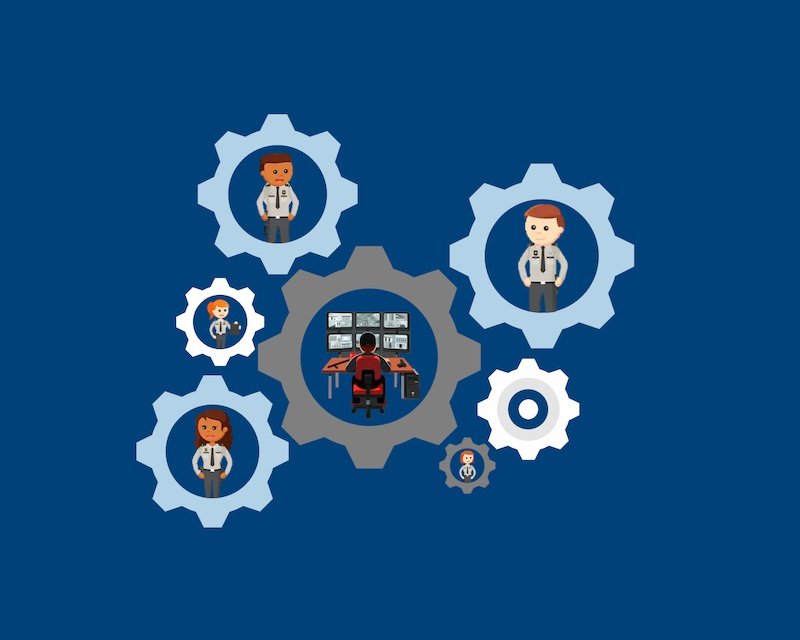
Business leaders have been diligently working to mitigate the disastrous, unexpected impact and risks presented to their employees, customers, and shareholders by the global COVID-19 pandemic. In addressing shareholder concerns and economic realities, many leaders have been responding by slashing costs wherever possible, including with their workforces.
Business leaders are struggling with the pressure to reduce costs while maintaining their security obligations.
A new challenge has arisen, however, as leaders still have the obligation to fulfill and fund essential aspects of their business, such as security, as well as the evolving threats and complexities involved therein. Fortunately, opportunities to be more efficient with security through better ways of working, shift patterns, organizational structures, ways to plan, and ways to leverage technology exist and can be unearthed with the right approach.This is the story of how M2P partnered with a U.S. security department in the transportation industry in 2019 to make itself more resilient to present and future crises (respecting no one has come out unscathed from COVID-19).
The Situation
For years the airport had been experiencing growth in not just operations, but also in asset size with new terminal and concourse facilities coming online. Combined with their immediate proximity to the local community as well as military installments, the airport’s security responsibilities were growing and becoming ever more complex.As at any airport, there are a myriad of security needs and issues to be addressed, such as defending against unauthorized intruders with malicious intent. In addition to traditional threats to aircraft, there are also rapidly evolving tactics to defend against. Airports also face threats from insiders, drones, cyber-attacks, and laser strikes, to name just a few. Public spaces at airports are also increasingly seen as targets and need to be provided adequate security coverage.
Security discussions tend to err on the side of emotions and subjectivity rather than numbers.To further muddle security’s complexities, the airport finds itself in a highly competitive environment with multiple alternative airports within a two-hour driving distance of its passenger catchment area. This competition drives extra pressure towards minimizing costs while preserving the customer experience. Given these responsibilities, as well as a perfect storm of business priorities, security is regularly challenged to optimize and justify their operating costs and staffing levels.
The Approach
Management discussions around security tend to err on the side of emotions and subjectivity rather than numbers and other business arguments. To field management’s challenges on cost and staffing levels, an objective, numbers-based approach was essential. With numbers in hand, it was assumed that conclusions could be made significantly more defendable.
Forecasting Workload Development
To first establish a common understanding of the status quo, a thorough and detailed inventory was taken of all responsibilities and activities carried out by the airport’s security staff and their associated commitment of time (i.e. hours per week). Combined with an analysis of what drives each activity’s workload (e.g. alarm frequency and time distribution profile), the security department was suddenly in a position to understand how workload would evolve based on the overall development of the airport’s business (i.e. operations, size) assuming no changes to coverage levels or ways of working.
Assessing Service Level Adherence
Opportunities to optimize coverage and service levels were then examined. Respecting TSA regulated metrics are generally non-negotiable, opportunities were identified in other areas. For example, waiting and turnaround times for airline employee access approvals and local public records requests were ripe with potential. With staff availability requirements adjusted to satisfy refreshed service level agreements, workload forecasts were updated accordingly.
To identify real opportunities and achieve agreement, a thorough inventory of activities is essential.
Identifying Efficiencies
Opportunities were then explored for if and how responsibilities could be performed more efficiently. To initiate and stimulate brainstorming with the security department, productivity and cost levels were first compared with similar organizations. Respecting no organization is the same as the next, figures were normalized on an activity-basis for making the benchmarks as comparable as possible. In that effort, qualitative context including technology, processes, and organizational setups in use helped bring meaning to the numbers, painting a multi-dimensional picture to inspire a top-down comparison.
Any benchmarks to be considered need to be normalized on an activity-basis; no organization is the same.The organization’s unique setup and ways of working were then examined bottom-up. Use of technology, flow of processes, outsourcing strategies, and organizational structure were especially examined. While efficiency was inspired by principles of Lean Manufacturing and Six Sigma, insights drawn from the earlier benchmarking also helped in substantiating new practices to be pursued. Earlier workload forecasts were then finalized accordingly.
Key Opportunities Uncovered
The initiative revealed a variety of opportunities to instill more efficient and resilient workforce practices, each ranging in benefit, cost, and time-to-realize.
Cross-utilizing Staff
Within the organization’s Security Operations Center, personnel had been dedicated to monitoring and responding to alarms 24/7. Similarly, the organization had personnel dedicated to handling calls 24/7. Considering each unit had variability in the frequency and time distribution of alarms and calls, staff utilization levels were found to be significantly low. Yet upon analysis of the workload patterns and timings, which were found to be complementary, it became evident that the responsibilities could be combined without sacrificing service level agreements.
Digitization
Employees performing security inspections and citation issuances were manually logging summary reports at the end of their shift. In order to save time, digitized inspection and citation forms would allow the employees to document these checks in the moment via mobile devices, completely removing an antiquated process from their responsibilities and freeing up time for higher value-add activities.
Analytics
The organization is beholden to internal audits as well as those of the TSA. The collection of associated data was a time-critical, yet complicated and effort-intensive, process. Implementing advanced analytics for the access control systems would allow for automatic collection of data useful for both TSA and internal audits, as well as the added benefit of support in monitoring for insider threats. Similarly, expanded use of advanced video analytics for surveillance would increase security on the perimeter, as well as in public areas. This would also cut down on efforts for performing manual video check requests.
Span-of-control
The evolution of work in any organization generally leads to reporting layers and situations that later prove out-of-date and no longer appropriate. Combined with the effects of work automation, the evolving nature of security work can especially leave organizational structures unfit for their purpose. To this end, the span-of-control was scrutinized to ensure a balance of management support relative to the ‘frontline’ security staff generating direct value for the organization.
Identity Management Transformation
When applying for an access credential / badge, it is standard procedure for multiple authentications to be performed based on the level of clearance required, through various organization, local, and federal checks. With much of the process being paper-based, and many requests being repetitive, an opportunity was identified. Digitizing this process would remove double work performed by those processing the applications, as well as the credential-requesting employees. Furthermore, the nature of the related system would allow for additional efficiencies in analyzing data.
Workforce Management Automation
Manually created staff plans and assignments generally come with shortcomings (i.e. missed productivity potential). In fact, the very act of managing workforces manually is itself inefficient. An automated workforce management system would not only increase frontline staff productivity but also maximize the productivity of back-office planners through manage-by-exception processes.
Geolocation Tracking
The best staff member to respond to a security breach wasn’t always clear to dispatchers, leading to confusion and often sub-optimal allocations. Geolocation services for tracking staff would increasingly allow the right employees to be identified for responding to events, rather than assigning staff at relative random.
System Integration
Given the plethora of security systems in disparate operation, complications (or at the very least confusion) arose. Introducing new integrations and extending existing ones between adjacent functions and systems would increase the efficiency of the related processes. For example, having the identity management system in communication with video surveillance system would allow for automated visual identification of employees accessing and egressing airport facilities.
Making the Case
As in the way this initiative was approached from the beginning, the results were delivered to the executives in the same objective, numbers-based fashion.The executives were taken through the journey of the study and afforded the opportunity to challenge every method, assumption, and conclusion that led to the efficiency potential determination of 14.2 %.
An efficiency potential of 14.2% was agreed amongst management.Through delivering the results in this way, it was clear for the executives where the ultimate headcount and cost conclusions came from. Thus, the executives were left in a position to make clear, confident, and timely decisions on how to move forward.
The Outcome
The conclusions found over the course of the study were accepted with many improvements already implemented or on the path to being implemented.In the end, the airport was able to holistically reassess how best to staff for security, resulting in reduced costs, increased security and safety, and improved customer experience.




